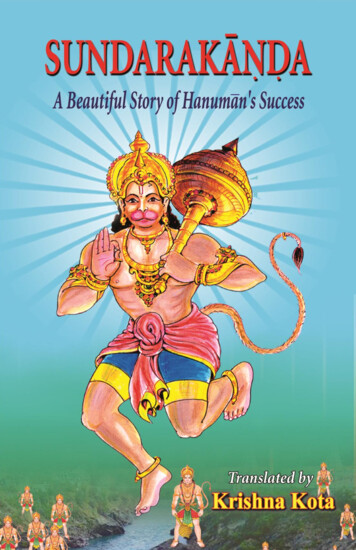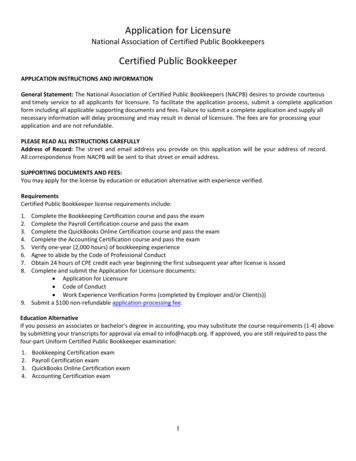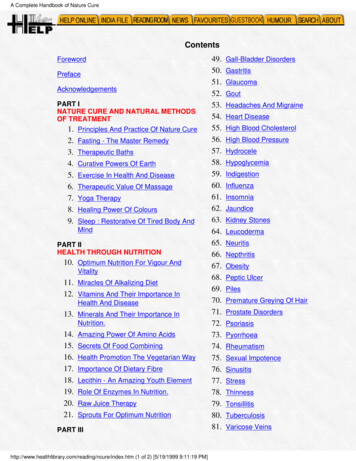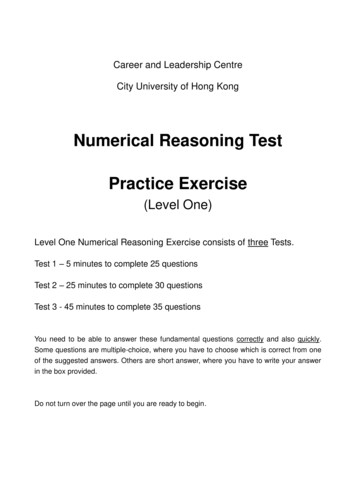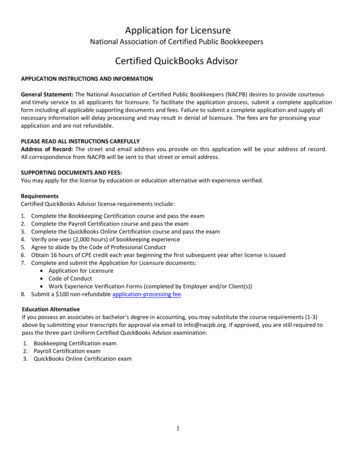
Transcription
om tat sat om Sri Raamaaya namah CompleteSundarakandafrom Valmiki Ramayanam.A chapter wise aggregation of the meaning of all slokas.A publication ofAthato Foundation.a Kasarabada Trust om tat sat 1
This is a publication of Athato Foundation, a Kasarabada Trust, 7061 PrestigeShantiniketan, Hoodi-ITPL Road, Mahadevapura Post, Bangalore 560048, India.All copy rights with the Athato Foundation unless otherwise specified.Not for salePrivate circulation onlyFirst EditionOctober 2017Silver Springs, Md.2
ContentsForeword5In Praise of Hanuman7A brief Chapter wise summary12Sarga 1 - Hanuman’s leap across the oceanSarga 2 - Hanuman enters Lanka at nightSarga 3 - Hanuman overcomes LankiniSarga 4 - Hanuman’s search in LankaSarga 5 - Hanuman’s search in LankaSarga 6 - Hanuman’s search in LankaSarga 7 - Hanuman sees Pushpaka VimanaSarga 8 - Description of Pushpaka VimanaSarga 9 - Hanuman enters Ravana’s palaceSarga 10- Hanuman sees Mandodari and thinks she is Sita15252831343740424448Sarga 11- Hanuman in the Banquet hallSarga 12- Hanuman’s griefSarga 13- Hanuman at a loss then sees Ashoka groveSarga 14- Hanuman enters Ashoka groveSarga 15- Hanuman sees SitaSarga 16- Hanuman in distress seeing SitaSarga 17- Hanuman sees the Rakshasa women guarding SitaSarga 18- Ravana enters Ashoka groveSarga 19- Sita’s distress on seeing RavanaSarga 20- Ravana proposes51545660636769727476Sarga 21- Sita turns down RavanaSarga 22- Ravana’s ultimatumSarga 23- Rakshasa women pursue Sita on behalf of RavanaSarga 24- Rakshasa women threaten SitaSarga 25- Sita’s response to threatsSarga 26- Sita’s despair and resolution to give up lifeSarga 27- Trijata’s dreamSarga 28- Sita’s wailingSarga 29- Good omensSarga 30- Hanuman’s resolve798184868991949799101Sarga 31- Hanuman sings Rama’s storySarga 32- Sita perplexedSarga 33- Hanuman speaks to SitaSarga 34- Sita’s doubtsSarga 35- Hanuman’s eloquence on Rama and his missionSarga 36- Hanuman gives Rama’s signet ring to SitaSarga 37- Hanuman’s offer- Sita’s doubts about Hanuman’s CapabilitiesSarga 38- Story of the crowSarga 39- Sita’s misgivings and Hanuman’s reassuranceSarga 40- Hanuman takes leave to go back1041061081101131181211251291323
Sarga 41- Destruction of Ashoka groveSarga 42- Kinkara’s killed & Jaya mantraSarga 43- Hanuman’s proclamationSarga 44- Jambumali killedSarga 45- Sons of the minister killedSarga 46- Five generals killedSarga 47- Prince Aksha killedSarga 48- Infdrajit captures Hanuman using Brahma AstraSarga 49- Hanuman sees Ravana in his courtSarga 50 - Ordered by Ravana Prahasta questions Hanuman134136139141143145148151155157Sarga 51- Hanuman’s advice to RavanaSarga 52- Vibhishana pleadsSarga 53- Hanuman’s tail set on fire & Sita’s prayersSarga 54- Lanka set on fireSarga 55- Hanuman’s fearsSarga 56- Hanuman takes leave of Sita and the leaps to Northern shoresSarga 57- Hanuman reaches the northern shoresSarga 58- Hanuman recounts his trip to LankaSarga 59- Hanuman’s plan of actionSarga 60 Angada’s proposal – Jambavan’s direction159162164167170172174177184186Sarga 61- Vanaras in MadhuvanSarga 62- Dadhimukha pushed backSarga 63- Sugriva asks Dadhimukha to tell the Vanaras to report backSarga 64- Hanuman reports to Rama that Sita is safeSarga 65- Hanuman gives Sita’s ChudamaniSarga 66- Rama’s sorrowSarga 67- Hanuman narrates conversations with SitaSarga 68- Hanuman tells Rama that he restored confidence of Sita187189191193196199200203EpilogueThe End2052064
ForewordSundarakanda is part of Valmiki Ramayana. Valimiki Ramayana is the earliest epic in apoetic form in Sanskrit. It is known as “Adi kavya”, the first poem. The very first sloka inSanskrit literature, supposedly uttered by Valmiki, is part of Ramayana. Valmiki takenaback by the beauty and simplicity of the first sloka repeats it to himself and hisdisciples. He uses the same form to write the epic story of Rama called Ramayana atthe prodding of Brahma who also gives Valmiki an unlimited insight into the story ofRama. Ramayana is truly written in a very simple style that makes the meanings easilyunderstood if one is a student of Sanskrit. Most of the Indian languages are derivativesof Sanskrit. Some languages even if they are not derivatives, have absorbed most or allof the Sanskrit words into their language as is the case with Telugu and even Kannada.Proficiency in Sanskrit derivatives or languages which absorbed Sanskrit, is enough tounderstand the gist of a sloka even if one is not a student of Sanskrit.Sundarakanda forms the central part of Ramayana. According to many it is heart ofRamayana.Sundarakanda has a folklore associated with it from time immemorial. All the moderncommentaries including those brought out by the western scholars refer to it. Readingor recitation of Sundarakanda has been on par with similar recitation of holy books likeGita. It has been a daily parayana item in many a hindu household. Miracles have beenattributed to such parayana. It is more probable that the spirit of Sundarakanda, morespecifically the spirit of Hanuman in pursuing the goals against all odds, is absorbed inthe process of ‘parayana’. That spirit is probably what made the miracles happen.In any case Hanuman remains the central hero of Sundarakanda. Infact the tittle“Sundarakanda” is assumed to be based on the name “Sundara” associated withHanuman. Sundarakanda can be taken to mean the exploits of Sundara or Hanuman.As per tradition, when ever one wishes for some “fruit”, one undertakes Sundarakandaparayana. In our case the Sundarakanda parayana is in the form of re-writing all theSanskrit slokas in a prose order to make the meaning more easily self evident and thenwriting the meanings for all the slokas. Sundarakanda has nearly three thousand slokasin the sixty-eight Sargas or chapters. In addition to writing the prose order andmeanings in English, we have an added twist of writing the Sanskrit text in multiplelanguages Telugu, Kannada, Gujarati and Devanagari facilitating reading of Slokas inone’s own language. Thus, one has the option of Sanskrit text presented in Devanagari,Telugu, Kannada, and Gujarati with English Translation. These are available inkasarabada.org web site. This presentation of chapterwise summary of Sundarakandais based on essentially aggregating the meanings of all the translated slokas. This hasbeen a huge task. The fact that we could undertake the same and complete the same ina time bound form is itself the “fruit” we wished for.That we have aggregated the meanings of all the slokas has the charm that we are infact reading ‘complete Sundarakanda’ which is faithful to its original form albeit in a5
different language. But it also suffers from the difficulties that result in such truetranslations. There will be innumerable repetitions. There will be innumerabledescriptions which defy easy translation as well as understanding without addedhistorical or contextual notes. We have left both of them, namely the repetitions anddifficult translations in place as they are, in the spirit of being faithful to the original textOur foray into the ocean of Sundarakanda is actually much older than this effort. Thisbeing a favorite book of our parents, as per their wish and with their active guidance wehave brought out a “Samkshipta Sundarakanda”, which is shortened form ofSundarakanda. In Samkshipta Sundarakanda, the nearly three thousand slokas ofSundarakanda have been condensed to about three hundred slokas, while retaining theflow of the story. It has been brought out as a book in Telugu and English. It has beenan experience that energized us to do more and more.The current effort is a direct result of that energy. om tat sat 6
Om SriramIN PRAISE OF HANUMANHANUMASTUTI"Vikrantastvam samardhastvam" says Sita"Kritam Hanumata karyam" says Sri Rama"Tvayyeva Hanumanasti balam buddhi parakramah" saysSugrivaSuch is the awe-inspiring part played by Hanuman!From the time, he steps into the story counselling Sugriva not to be concerned aboutthe two Naras - Rama and Lakshmana -who entered their area, to the time he takes leaveof Sri Rama as a confirmed Ramabhaktha, devotee of Sri Rama, his exploits are surelymind boggling and in fact more so in Sundarakanda. No wonder that the popular adagegoes: 'Sundare Sundara Kapih', (In Sundara kanda beautiful is Hanuman). That refrainalso summarizes the inner beauty of Hanuman with all the accomplishments that beautifyhis character in Sundarakanda.In the very first meeting with Sri Rama, whom he approaches in the guise of a recluse,Sri Rama instantly recognizes the greatness of Hanuman. Sri Rama says to Lakshmana:"To converse in the way he (Hanuman) does is impossible, unless he studiedRigveda thoroughly, memorized Yajurveda along with meanings, and acquiredknowledge of Samaveda. Surely the entire range of Crammer has been studied by him inmany ways, as is clear from the fact that nothing has been wrongly worded, even thoughhe has voluminously spoken a great deal!"The very first impressions so created by Hanuman is maintained throughout thegreat epic -- Ramayana -- as reflected in his marvelous articulation either in addressingothers or himself (or in fact the reader!). Steadfast devotion to his duty, and the confidencehe projects in his handling of any task, however arduous, can be noticed in all his actions.7
Right from the beginning to the end, this impression of a wise and knowledgeableHanuman is reflected in several situations. It is so when he consoles bereaved Tara,informs Swayamprabha of the search party's mission, attempts to dissuade Angada fromfasting to death, or advising Ravana to do the right thing. Very rightly for the very first taskof searching for Sita, Sugriva says "There is no one equal to Hanuman!" - "on the earth,in the sky or air, or even in Heaven! Continuing further Sugriva says: "In you alone O'Hanuman! reside the three qualities, strength, wisdom and prowess!"Even with all these inherent qualities, it does seem that Hanuman himself is unaware ofhis capabilities, and needs to be prodded to undertake the impossible! This is evidentwhen Jambavan addresses Hanuman to undertake the arduous task of crossing theocean. Indeed, there is a hidden Hanuman in everybody who needs to be prodded, tomake him take up those seemingly impossible tasks.Sundarakanda starts with Hanuman all set for the arduous task of jumping acrossthe ocean in search of Sita. Hanuman announces his determination in no uncertain terms:"In every way I shall complete my task and come back with Sita or otherwise I shall uprootLanka with Ravana and carry it all the way here!' Proclaiming his goals, Hanumanproceeds to accomplish the same.In crossing the ocean Hanuman displays the three qualities "Balam, Buddhi, andParakramah" as stated by venerable Sugriva.The first arduous task was that of jumping across the ocean. As he proceeds acrossthe sky, Valmiki says ."The sun god does not scorch him . the wind god ministers himwith gentle and soothing breeze ."Actually, for Hanuman who was so steadfast on "Ramakryardha Siddhaye", namely“achieving Rama’s tasks” - neither the sun nor the wind could detract him from his goals.This is clearly reflected in his response, when Mainaka invites him to rest for a while:Hanuman's reply focuses on his own goals. “I have given my word not to stop in themiddle of my task". A determination that can only be emulated!At the next obstacle with Surasa Valmiki refers to Hanuman as “Vayuputrahsubudhiman". The emphasis is on "Vayuputrah subudhiman", namely Hanuman theintelligent. He overcomes Surasa, sent by Devas to test him, with his intelligence.8
However, while dealing with the next obstacle of Simhika - a demon - he uses hiswell-known prowess to kill her.Much in line with the first impression of Sri Rama about Hanuman as a man of greatknowledge and speech, one sees Hanuman go through a thoughtful reflection at everystage, like when he enters Lanka. When he searches for S it a and mistakenly thinks ofMandodari as Sita, he quickly corrects himself; "In separation from Rama, Sita is not likelyto sleep, eat, wear ornaments or drink."Many a time we see Hanuman swing between moods despondency and of strongself-belief while searching for Sita. The moral is 'we may go through seas of desperation,and yet one must strive and continue to achieve the ultimate goals'.When he fails to find Sita anywhere, Hanuman goes through a train of thoughts.Then he works out his course of his action: "I ought not yield to despair . . . I mustcontinue the search . Whatever happens, I must not give up the hopes of success."Worthy of emulation, is his mantra for success .When he approaches Sita in Lanka, his thinking process was on the crescendo andhe plans on how to address Sita. "Must speak in the language of the common man," aptto the situations. Otherwise, one may suspect a monkey speaking the language ofBrahmans”.As he engages himself in convincing Sita about his bonafides, Sita asks him todescribe Rama. In his answer, the eloquence of Hanuman shines through: "He (Rama)is the protector of all beings, of his people, of Dharma, and of good conduct" - in fact thelines he speaks of Rama essentially reflect the attributes required in a man entrustedwith Governance”.When he proposes to carry Sita on his shoulders back to Rama, watching his smallmonkey frame, Sita says: “Your proposal is precisely monkey-like!" This insult does notput off Hanuman. and he proceeds to show here the true dimensions of his real self andwins her confidence. Small people with smaller minds and larger egos get diverted fromtheir real goals when confronted with even minor affronts. Hanuman demonstrates that'perseverance is the hallmark of a' person focused on his goal.'Having achieved the purpose of locating Sita, Hanuman realizes that he will have toreturn to Lanka with Sri Ram to battle Ravana; He decides to do a little more to facilitate9
the next task of the ensuing battle. He hits upon an idea to get into the presence ofRavana. He proclaims loudly victory to Rama and identifies himself as the servant ofRama. These four slokas where he announces himself constitute the famous "JayaMantra." Tradition has it, that these slokas be chanted, whenever one is embarking on anew venture and desires victory!While confronting Ravana in the Raj Sabha, Hanuman again brings out his skills asa learned ambassador, though with no avail. When Ravana orders that Hanuman’s, tailbe torched, he bums down Lanka. Yet, concerned about the safety of Sita, herealizes the dangers of any thoughtless action propelled by anger: “An angry man mayprecipitate a sinful act . may even kill elders and may insult pious souls in harsh tones."And then he says “He alone can be called a 'man' who can do away with the anger thathas sprung up in his heart”.Hanuman turns a narrator par excellence that he is while recounting the wholeepisode, from the time he left the Vanaras on the Mahendra mountain, till his return.As the Vanaras return along with Hanuman, Sugriva was sure of Hanuman beingin the forefront of that success. Sugriva tells Lakshmana "Without a doubt Sita has beenlocated, surely by no other person than Hanuman." Such is the belief in Hanuman.The Yuddhakanda highlights Hanuman's great valor and his importance to theVanara Army. When the Brahmaastra released by Indrajit disabled even mighty Sri Ramaand Lakshmana, and scores of others, Vibhishana and Hanuman set about locating thesurvivors. When they find injured Jambavan, Jambavan’s first question to Vibhishanawas about the welfare of Hanuman! A perplexed Vibhishana asks Jambavan as to whyhe is inquiring about Hanuman instead of Sri Rama or Lakshmana. The reply is asilluminating as it can be."If Hanuman is alive we are all sure to be saved. But, if he is no more, we are asgood as dead even if we are alive".That then is the importance of Hanuman.Praise for Hanuman comes straight from the depths of his heart as Rama says:"What any other man cannot think of or even conceive, this Hanuman has actuallyperformed for me!"10
Sita concurs with Rama. At the time of Pattabhisheka Rama asks Sita to give thegarland of pearls to the one who deserves it most, saying: "Give it to him in whom thesequalities shine .". She presents the necklace, the garland of pearls to Hanuman.When the time comes to take leave. Hanuman says, "0' Rama! Please bless me sothat my affection for you never diminishes. Do not allow me to think of anything else ordivide my attention between you and any other person. I want to live as long as your greatname flourishes amidst humanity. Let me be, for ever and ever, your humble devotee."Sri Rama says:"As long as my story is told and retold amongst men, so long shall your fame bepart of it."And so it is!!Dr Sachidananda C Kasarabada om tat sat 11
om tat sat ततो रावण नीतायााः सीतायााः शत्रुकर्षणाः �ं चारणाचररते पथे ॥1 Then following the path of the celestial bards Hanuman, the destroyer of enemies resolved to search forSita carried away by Ravana. om tat sat SundarakandaA brief chapter wise SummarySundarakanda starts with a positive exuberance of Hanuman's leap across the ocean( Chapter 1) moving away from prevailing gloom all over in the context of Ramayanawherein we see Rama at a loss without Sita, the Vanaras at a loss unable to find out thewhereabouts of Sita, Sita at loss as captive prisoner of Ravana. Hanuman’s flight providesa hope. After landing in Lanka Hanuman plans to enter the city of Lanka (Chapter 2).Then tackling Lankini, the demon guarding Lanka ( Chapter 3) Hanuman moves throughLanka ( Chapters 4 , 5 and 6). He sees Ravana's gorgeous palace ( Chapter 7), thePushpaka Vimana( Chapter 8), the City of Lanka ( Chapter 9) and Ravana in hispalace ( Chapter 10). He is delighted mistaking Mandodari for Sita, quickly realizes hiserror (Chapter 11). Loses his heart on not being able to locate Sita ( Chapter 12 ). Butwith renewed vigor continues the search. Then he sees Ashok van ( Chapter13) , enters the same (Chapter 14) and finds Sita (Chapter 15) . The seeds ofHanuman's respect for Sita are sown in Chapter 16 and 17.Then Hanuman sees Ravana entering the Ashokvan (Chapter 18). Ravana enters( Chapter 19) Ashokvan to plead his case (Chapter 20) with Sita , who rejects hisarguments summarily( Chapter 21). Ravana then threatens Sita and leaves ( Chapter 22).Then we hear the Rakshasa women try to threaten and cajole Sita ( Chapters23, 24, 25, 26). Then we hear Trijata telling about her dream ( Chapter 27) which foretoldthe victory of Rama. Sita too is pleased about Trijata dream but still despondent abouther own situation ( Chapter 28). Hanuman quickly mulls over the events ( Chapter 29) ofthe day and decides on the course of action ( Chapter 30) Then sings a song in praise ofSri Rama (Chapter 31). Sita is surprised to hear the song in praise of SriRama ( Chapter32). Hanuman then enquires from Sita. Sita tells her story ( Chapter 33). But quickly Sitahas doubts about Hanuman ( Chapter 34) and Hanuman clears them by describingRama's characteristics ( Ramuni- gunaalu - Chapter 35) .Then Hanuman hands over Rama's 'Anguliyakam' ( Chapter 36). Hanuman offers to carrySita back ( Chapter 37) which Sita refuses. Sita says it is more appropriate for Rama tocome defeat Ravana and take her back! Then Sita tells the story of Kakasura ( Chapter38) and asks Hanuman to impress on Rama to come quickly as only two months are left.As Hanuman prepares to go back ( Chapter 39) Sita gives her message( Chapter 40).Then Hanuman plans on next steps ( Chapter 41). He decides to take on Ravana'swarriors and he lets go with his victory roar!! (Jaya mantram - Chapter 42). Then we seeHanuman battle Kimkaras ( Chapter 43), Jambumali (Chapter 44) , the minister's sons( Chapter 45), the five generals ( Chapter 46), Aksha Kumara( Chapter 47)and finally12
Indrajit ( Chapter 48). Captured by Indrajit, Hanuman is taken to the assembly ( Chapter49) where he is questioned ( Chapter 50)Hanuman tells that he is messenger of Sri Rama ( Chapter 51) and advises Ravana toreturn Sita. Ravana orders Hanuman be killed (Chapter 52). But dissuaded by Vibhishana,Ravana orders that Hanuman's tail be set on fire ( Chapter 53). Sita prays for Hanuman'ssafety. Fire does not affect Hanuman( Chapter 54 ). But Hanuman sets city of Lanka onfire. After burning down Lanka Hanuman is worried that Sita too might have perished( Chapter 55). Realizing that she is safe he takes her leave ( Chapter 56). Hanuman thenflies back to Mahendra mountain ( Chapter 57) from the southern shores. He tells the fullstory of his exploits ( Chapter 58) to the waiting Vanaras. Then he suggests that thefurther course of action be decided ( Chapter 59). Jambavan suggests that they go andinform Sri Rama ( Chapter 60 ).The Vanaras on return journey stop at Madhuvan, a protected garden of the King ofVanaras( Chapter 61) for fun. Unable to protect the Madhuvan from intruding Vanaras,Dadhimukha the guard goes to complain to King Sugriva ( Chapter 62). Sugriva andLakshmana realizes that the Vanaras in their exuberance of success of their missionlanded in Madhuvan. Sugriva tells Dadhimukha to send Vanaras back to see himimmediately (Chapter 63).Hanuman and others move on to meet Sri Rama and inform Sri Rama about the safetyof Sita ( Chapter 64). Hanuman gives a detailed account ( Chapter 65). Rama asksHanuman to tell everything about Sita (Chapter 66). Hanuman narrates his conversations(Chapter 67). He tells Sri Rama that with his assurances of returning with SriRama, heprovided confidence and peace to the troubled mind of Sita ( Chapter 68)! om tat sat ततो �णा �प्रसाददता।जगाम िाांततां मममैथिलात्मजा तवाषि िोकेन तदाsशभिीडिता॥29 ’Then the princess of Mithila, Sita who was in grief of separation from you, pleased with soothing andauspicious words spoken by me, became peaceful”. om tat sat 13
Sundarakandafrom Valmiki Ramayanam.A chapter wise summary of all slokas14
om tat sat ततो रावण नीतायााः सीतायााः शत्रुकर्षणाः �ं चारणाचररते पथे ॥1 स॥तताः रावण नीतायााः सीतायााः पदुं अन्वेष्ुुं (हनुमान)् शत्रुकर्षणाः चारणाचररते पथथ (चररतुुं)इयेर् ॥Then following the path of the celestial bards Hanuman, the destroyer of enemies, resolved to search forSita carried away by Ravana.SundarakandaSarga 1Hanuman’s leap across the ocean(Preamble: With Rama having lost his wife Sita, who was abducted by the Rakshasaking Ravana, with Vanaras facing a huge obstacle in the form of an ocean to be crossedin their search of Sita, with Sita lost in a sea of sorrow being a captive of Ravana,Sundarakanda starts in a background of prevailing doom. It is at this juncture thatJambavan deprecating his own capabilities and praising Hanuman’s capabilitiesprompts Hanuman to cross the ocean in search of Sita. Hanuman agrees for the sameprompting soaring of spirits all-round anticipating success.)Then following the path of the celestial bards Hanuman, the destroyer of enemiesresolved to search for Sita carried away by Ravana.Intending to accomplish the very difficult action of crossing the ocean which had norival, Hanuman raised his head and neck. Then he appeared like the king of bulls. Thenthe mighty Hanuman strolled on the green grassy lands with a sheet of water happily.The wise Hanuman scaring the birds and many other animals, uprooting and tramplingthe trees with his chest, went about like a lion. The mountain with its natural blue redgreen and yellow colors as well as white and black colors of minerals looked as if it isdecorated all over.The mountain was very much frequented by, Yakshas, Kinnaras, Gandharvas,Pannagas and people who can take any form they please, along with their retinues.They were looking like gods. The best of Vanaras standing at the center of thatmountain filled with lordly elephants looked like an elephant.Offering salutations to Sun, Indra, Vayu, the creator and all the elements, Hanumandecided in his mind to proceed to Lanka. Facing east and offering salutations to hisfather, the wind god, the capable Hanuman grew in size to go in the southern direction.Then having resolved to take a leap for achieving the task of Rama while being seen bythe all the Vanara chiefs, Hanuman grew in size like the sea during the full moondays. With an immeasurable size of body to cross the ocean Hanuman started to putpressure on the mountain with his feet and hands in preparation for his leap.15
The immovable one namely the mountain also for a moment was shaken by thepressure exerted by the Vanara. Then the flowers on the top of trees fell down. Themountain covered with the fragrant flowers fallen from the trees, looked like a mountainof flowers. Pressed by the highly valiant one, that mountain let go of waters like theelephant in rut. The Mahendra mountain, pressurized by his might, let go of streams ofgold and silver. The mountain let go of big boulders with sulphur pigments just like fireemits columns of smoke possessed with fire. Being shaken by the mountain all thebeings living in the caves shrieked with horrible sounds. Caused by the crushing powerof the mountain, the loud noises made by all the creatures filled all the groves on earthin all directions.The snakes with the signs of swastika on their foreheads, scared by the noises allaround bit the rocks with their fangs producing great fire. Then the mountain bitten bythe angry and venomous snakes and burnt by the fire broke into thousands of pieces.The medicinal plants capable of counteracting the poisons, grown on the mountain werenot enough to neutralize the poison spewed by the snakes.Thinking that this mountain is breaking up, the scared ascetics as well as theVidyadharas along with their women folk flew up in fear. In their fear, valuable vessels,golden drinking cups with golden goblets were left behind. Food that was licked, varioustype of small and big eatables, meat, hides of bulls, swords covered with goldensheaths were all left behind. The Vidyadharas, intoxicated, wearing valuable chains,wearing garlands with red lotus like eyes, and red unguents flew into the sky.Wonder struck women wearing necklaces, anklets and armlets stayed up in the sky withtheir lovers smiling gently. The great seers among Vidhyadharas, proficient in allstudies, were also watching the mountain, staying up in the sky.Then the sounds of seers who are seekers of truth, Siddhas, Charanas who stay in theskies were heard. They said, ' This son of wind god, the swift Hanuman of the size of amountain is desiring to cross the ocean which is the abode of crocodiles. The othershore of the ocean is very difficult to reach. He wants to reach the other shore of theocean to achieve a difficult task, for the sake of Rama and for the sake of Vanaras '.The Vidyadharas having heard the words of the ascetics, saw Hanuman the bull amongVanaras whose strength is immeasurable. The great Hanuman as huge as a mountainshook his hair on his body and produced a great sound thundering like a cloud.Like the king of birds shaking a serpent, he shook his tail covered with hair in order totake off. The tail curled at his back looked like the great serpent being carried off byGaruda. The Vanara pressing down his arms which are looking like iron clubs, firmly onthe mountain, crouched his waist and contracted his feet. The gloriousHanuman contracted his shoulders and the head similarly, and summoned up energy aswell as vigor. Setting up his eyes to look up in the direction in which he has to leap, herestrained his breath in his chest. The elephant among the Vanaras, keeping his feet16
firmly in that position, contracting his ears, ready to fly said the following to the Vanaraswho were watching.' With the speed of wind, like the arrow released by Rama, I will go the Lanka ruled byRavana. If I do not see Janaka's daughter in Lanka, then with the same speed I will goto the abode of gods, If I do not find Sita in heaven in spite of all my efforts, then I willbind that king of Rakshasas and bring him here. By all means completing my task, I willcome back here along with Sita. Otherwise I will uproot Lanka along with Ravana andbring him here'.Having said this to the Vanaras the swift Hanuman who is the best amongVanaras, leaped into the sky without any effort. Hanuman, the elephant among Vanarasthought himself like the bird Suparna.As he took off with speed, all the trees with branches flew along with him. The speed ofhis thighs swept way the lapwings in heat on the trees full of flowers as he coursedthrough the cloudless sky. Pulled along by the speed of his thighs, the trees followed fora distance like the relatives follow the kin on a long journey. Uprooted by the force of histhighs, Sala trees and other great trees followed him like the army following the king.With many trees having blossoms at the top following him, the Vanara, mountain likeHanuman appeared in a fantastic form. Then the huge trees fell off into the ocean likethe mountains which fell into the sea out of fear of Indra.Covered with many different kinds of flowers, buds and sprouts spread over like a cloud,Hanuman shone brightly like a mountain covered with fireflies. Free of his speed thetrees shedding the flowers fell off into the sea like the friends who return after followingthe departing relative for some distance.Driven by the wind caused by the speed of the Vanara, the trees with variety of flowersfell on the ocean. The trees and flowers being light rose up in the sea and the seashone like the sky with stars. Stuck with flowers of different colors, the Vanara lookedlike the clouds glowing with lightning. The sea water, with the flowers dropped by hisspeed, looked like the firmament with rising stars. The arms stretched out in the skyemerging from the mountain looked like five headed serpents. The great Vanara lookedlike a thirsty one drinking the sea with rising waves.Following the path o
languages Telugu, Kannada, Gujarati and Devanagari facilitating reading of Slokas in one’s own language. Thus, one has the option of Sanskrit text presented in Devanagari, Telugu, Kannada, and Gujarati with English Translation. These are available in kasarabada.org web site.
